Integrating Passive Energy Efficient Measures to the Building Envelope of a Multi-Apartment Building in Sweden: Analysis of Final Energy Savings and Cost Effectiveness
Abstract
:1. Introduction
1.1. State of the Art
1.2. Aim and Purpose
2. Methodology
2.1. Applied EEMs
2.2. Economic Scenarios
2.3. Case-Study Building
2.4. Energy Simulation
3. Results
3.1. Final Energy Savings and Investment Costs
3.2. Cost-Effectiveness Analysis
Marginal Cost-Effectiveness Analysis
3.3. EEM Packages under the Different Economic Scenarios
3.4. Sensitivity Analysis of the Assumed Lifespan of the EEMs
4. Discussion
5. Conclusions
Author Contributions
Funding
Data Availability Statement
Conflicts of Interest
Appendix A
| Insulation Material Type | Thickness [mm] | U-Value [W/m2 K] | Space Heating Demand [mwh/Year] | Final Energy Savings [mwh/Year] | Peak Load [kw] | Total Investment Assuming Energy Renovation [kEuro] | Marginal Investment Assuming Energy Renovation [kEuro] | Total Investment Excluding the Replacement Costs of Any Deteriorated Parts [kEuro] | Marginal Investment Excluding the Replacement Costs of Any Deteriorated Parts [kEuro] |
|---|---|---|---|---|---|---|---|---|---|
| Reference | - | 0.510 | 126.77 | - | 63.14 | - | - | - | - |
| Mineral wool | 50 | 0.299 | 119.73 | 7.04 | 61.80 | 7.50 | - | 2.70 | - |
| 100 | 0.211 | 116.97 | 9.81 | 61.11 | 8.88 | 1.38 | 4.08 | 1.38 | |
| 150 | 0.163 | 115.24 | 11.53 | 60.66 | 10.00 | 1.12 | 5.20 | 1.12 | |
| 200 | 0.133 | 113.93 | 12.85 | 60.30 | 11.11 | 1.12 | 6.31 | 1.12 | |
| 250 | 0.112 | 113.11 | 13.66 | 60.09 | 12.23 | 1.12 | 7.43 | 1.12 | |
| 300 | 0.097 | 112.18 | 14.60 | 59.83 | 13.61 | 1.38 | 8.81 | 1.38 | |
| 350 | 0.086 | 111.79 | 14.99 | 59.64 | 14.72 | 1.12 | 9.93 | 1.12 | |
| 400 | 0.077 | 111.25 | 15.53 | 59.52 | 16.10 | 1.38 | 11.31 | 1.38 | |
| 450 | 0.069 | 110.65 | 16.12 | 59.34 | 17.49 | 1.38 | 12.69 | 1.38 | |
| 500 | 0.063 | 109.86 | 16.91 | 59.22 | 18.87 | 1.38 | 14.07 | 1.38 | |
| Glass wool | 50 | 0.288 | 119.43 | 7.34 | 61.76 | 7.84 | - | 3.04 | - |
| 100 | 0.201 | 116.64 | 10.13 | 61.06 | 9.57 | 1.72 | 4.77 | 1.72 | |
| 150 | 0.154 | 114.94 | 11.83 | 60.64 | 11.03 | 1.46 | 6.23 | 1.46 | |
| 200 | 0.125 | 113.66 | 13.11 | 60.31 | 12.49 | 1.46 | 7.69 | 1.46 | |
| 250 | 0.105 | 112.86 | 13.91 | 60.05 | 13.94 | 1.46 | 9.15 | 1.46 | |
| 300 | 0.091 | 111.95 | 14.82 | 59.86 | 15.67 | 1.72 | 10.87 | 1.72 | |
| 350 | 0.080 | 111.59 | 15.19 | 59.79 | 17.13 | 1.46 | 12.33 | 1.46 | |
| 400 | 0.071 | 111.06 | 15.71 | 59.54 | 18.85 | 1.72 | 14.05 | 1.72 | |
| 450 | 0.064 | 110.49 | 16.29 | 59.47 | 20.57 | 1.72 | 15.78 | 1.72 | |
| 500 | 0.058 | 109.70 | 17.07 | 59.27 | 22.30 | 1.72 | 17.50 | 1.72 | |
| EPS | 50 | 0.510 | 119.85 | 6.93 | 61.86 | 7.68 | - | 2.88 | - |
| 100 | 0.303 | 117.08 | 9.69 | 61.17 | 9.24 | 1.56 | 4.44 | 1.56 | |
| 150 | 0.215 | 115.34 | 11.43 | 60.74 | 10.53 | 1.30 | 5.74 | 1.30 | |
| 200 | 0.167 | 114.03 | 12.75 | 60.38 | 11.83 | 1.30 | 7.03 | 1.30 | |
| 250 | 0.136 | 113.19 | 13.58 | 60.17 | 13.13 | 1.30 | 8.33 | 1.30 | |
| 300 | 0.115 | 112.25 | 14.52 | 59.91 | 14.68 | 1.56 | 9.89 | 1.56 | |
| 350 | 0.099 | 111.85 | 14.92 | 59.81 | 15.98 | 1.30 | 11.18 | 1.30 | |
| 400 | 0.088 | 111.31 | 15.47 | 59.59 | 17.54 | 1.56 | 12.74 | 1.56 | |
| 450 | 0.078 | 110.71 | 16.06 | 59.54 | 19.10 | 1.56 | 14.30 | 1.56 | |
| 500 | 0.071 | 109.92 | 16.86 | 59.31 | 20.66 | 1.56 | 15.86 | 1.56 |
| Insulation Material Type | Thickness [mm] | U-Value [W/m2 K] | Space Heating Demand [mwh/Year] | Final Energy Savings [mwh/Year] | Peak Load [kw] | Total Investment Assuming Energy Renovation [kEuro] | Marginal Investment Assuming Energy Renovation [kEuro] | Total Investment Excluding the Replacement Costs of Any Deteriorated Parts [kEuro] | Marginal Investment Excluding the Replacement Costs of Any Deteriorated Parts [kEuro] |
|---|---|---|---|---|---|---|---|---|---|
| Reference | - | 0.320 | 126.77 | - | 63.14 | - | - | - | - |
| Mineral wool | 50 | 0.221 | 121.28 | 5.49 | 62.17 | 40.48 | - | 16.25 | - |
| 100 | 0.157 | 121.13 | 5.64 | 62.09 | 51.66 | 11.18 | 27.44 | 11.18 | |
| 150 | 0.136 | 116.97 | 9.8 | 61.20 | 62.84 | 11.18 | 38.62 | 11.18 | |
| 200 | 0.115 | 115.24 | 11.53 | 60.78 | 73.30 | 10.46 | 49.08 | 10.46 | |
| 250 | 0.099 | 113.91 | 12.86 | 60.50 | 85.39 | 12.09 | 61.17 | 12.09 | |
| 300 | 0.087 | 112.78 | 13.99 | 60.24 | 95.85 | 10.46 | 71.63 | 10.46 | |
| 350 | 0.078 | 111.85 | 14.92 | 60.07 | 107.34 | 11.48 | 83.11 | 11.48 | |
| 400 | 0.070 | 110.89 | 15.88 | 59.83 | 118.40 | 11.06 | 94.17 | 11.06 | |
| 450 | 0.064 | 110.54 | 16.23 | 59.77 | 129.88 | 11.48 | 105.66 | 11.48 | |
| 500 | 0.059 | 109.65 | 17.12 | 59.54 | 141.37 | 11.48 | 117.14 | 11.48 | |
| Glass wool | 50 | 0.215 | 121.02 | 5.75 | 62.13 | 41.07 | - | 16.84 | - |
| 100 | 0.162 | 118.32 | 8.45 | 61.56 | 52.84 | 11.77 | 28.61 | 11.77 | |
| 150 | 0.130 | 116.65 | 10.12 | 61.22 | 64.61 | 11.77 | 40.39 | 11.77 | |
| 200 | 0.115 | 114.95 | 11.82 | 60.80 | 75.66 | 11.05 | 51.43 | 11.05 | |
| 250 | 0.093 | 113.62 | 13.15 | 60.52 | 88.33 | 12.67 | 64.11 | 12.67 | |
| 300 | 0.082 | 112.52 | 14.25 | 60.27 | 99.38 | 11.05 | 75.16 | 11.05 | |
| 350 | 0.073 | 111.61 | 15.16 | 60.09 | 111.46 | 12.07 | 87.23 | 12.07 | |
| 400 | 0.065 | 110.66 | 16.11 | 59.86 | 123.11 | 11.65 | 98.88 | 11.65 | |
| 450 | 0.060 | 110.33 | 16.44 | 59.83 | 135.18 | 12.07 | 110.95 | 12.07 | |
| 500 | 0.055 | 109.70 | 17.07 | 59.60 | 147.25 | 12.07 | 123.03 | 12.07 | |
| EPS | 50 | 0.256 | 123.26 | 3.51 | 62.61 | 40.80 | - | 16.58 | - |
| 100 | 0.171 | 118.74 | 8.03 | 61.64 | 52.31 | 11.51 | 28.09 | 11.51 | |
| 150 | 0.139 | 117.07 | 9.7 | 61.27 | 63.82 | 11.51 | 39.60 | 11.51 | |
| 200 | 0.117 | 115.35 | 11.42 | 60.87 | 74.61 | 10.79 | 50.38 | 10.79 | |
| 250 | 0.101 | 114.00 | 12.77 | 60.59 | 87.02 | 12.41 | 62.80 | 12.41 | |
| 300 | 0.089 | 112.87 | 13.9 | 60.32 | 97.81 | 10.79 | 73.58 | 10.79 | |
| 350 | 0.079 | 111.94 | 14.83 | 60.11 | 109.62 | 11.81 | 85.39 | 11.81 | |
| 400 | 0.072 | 110.97 | 15.80 | 59.87 | 121.00 | 11.39 | 96.78 | 11.39 | |
| 450 | 0.065 | 110.62 | 16.15 | 59.83 | 132.81 | 11.81 | 108.59 | 11.81 | |
| 500 | 0.060 | 109.72 | 17.05 | 59.63 | 144.62 | 11.81 | 120.40 | 11.81 |
| Insulation Material Type | Thick-Ness [mm] | U-Value [W/m2 K] | Space Heating Demand [mwh/Year] | Final Energy Savings [mwh/Year] | Peak Load [Kw] | Total Investment Assuming Energy Renovation [kEuro] | Marginal Investment Assuming Energy Renovation [kEuro] | Total Investment Excluding the Replacement Costs of Any Deteriorated Parts [kEuro] | Marginal Investment Excluding the Replacement Costs of Any Deteriorated Parts [kEuro] |
|---|---|---|---|---|---|---|---|---|---|
| Reference | - | 2.700 | 126.77 | - | 63.14 | - | - | - | - |
| Foam glass | 50 | 0.730 | 124.97 | 1.80 | 63.12 | 20.31 | - | 9.57 | - |
| 100 | 0.422 | 124.13 | 2.64 | 62.97 | 29.50 | 9.19 | 18.76 | 9.19 | |
| 150 | 0.297 | 123.64 | 3.13 | 62.89 | 39.15 | 9.65 | 28.41 | 9.65 | |
| 200 | 0.229 | 122.93 | 3.84 | 62.76 | 54.69 | 15.55 | 43.96 | 15.55 | |
| 250 | 0.186 | 122.50 | 4.27 | 62.68 | 63.61 | 8.92 | 52.88 | 8.92 | |
| 300 | 0.157 | 122.11 | 4.66 | 62.61 | 73.99 | 10.38 | 63.26 | 10.38 | |
| 350 | 0.136 | 121.77 | 5.00 | 62.54 | 82.92 | 8.92 | 72.18 | 8.92 | |
| 400 | 0.120 | 121.53 | 5.25 | 62.50 | 94.68 | 11.77 | 83.95 | 11.77 | |
| 450 | 0.107 | 121.38 | 5.39 | 62.47 | 104.53 | 9.85 | 93.80 | 9.85 | |
| 500 | 0.096 | 121.05 | 5.72 | 62.36 | 115.90 | 11.37 | 105.17 | 11.37 | |
| EPS | 50 | 0.581 | 124.42 | 2.36 | 63.00 | 13.12 | - | 7.75 | - |
| 100 | 0.326 | 123.80 | 2.97 | 62.93 | 15.12 | 2.00 | 9.75 | 2.00 | |
| 150 | 0.226 | 123.29 | 3.48 | 62.85 | 17.58 | 2.46 | 12.21 | 2.46 | |
| 200 | 0.173 | 122.57 | 4.20 | 62.71 | 25.93 | 8.36 | 15.20 | 2.99 | |
| 250 | 0.140 | 122.13 | 4.64 | 62.63 | 27.67 | 1.73 | 16.94 | 1.73 | |
| 300 | 0.118 | 121.76 | 5.02 | 62.56 | 30.86 | 3.19 | 20.12 | 3.19 | |
| 350 | 0.102 | 121.42 | 5.35 | 62.50 | 32.59 | 1.73 | 21.86 | 1.73 | |
| 400 | 0.089 | 121.20 | 5.57 | 62.45 | 37.17 | 4.58 | 26.44 | 4.58 | |
| 450 | 0.080 | 121.07 | 5.71 | 62.43 | 39.83 | 2.66 | 29.10 | 2.66 | |
| 500 | 0.072 | 120.60 | 6.17 | 62.33 | 44.01 | 4.18 | 33.28 | 4.18 | |
| XPS | 50 | 0.543 | 124.66 | 2.12 | 63.07 | 16.83 | - | 11.46 | - |
| 100 | 0.302 | 123.70 | 3.07 | 62.91 | 22.53 | 5.71 | 17.17 | 5.71 | |
| 150 | 0.209 | 123.18 | 3.60 | 62.83 | 28.71 | 6.17 | 23.34 | 6.17 | |
| 200 | 0.160 | 122.80 | 3.98 | 62.75 | 35.41 | 6.70 | 30.04 | 6.70 | |
| 250 | 0.130 | 122.02 | 4.75 | 62.62 | 40.85 | 5.44 | 35.48 | 5.44 | |
| 300 | 0.109 | 121.65 | 5.12 | 62.53 | 47.75 | 6.90 | 42.38 | 6.90 | |
| 350 | 0.094 | 121.33 | 5.45 | 62.47 | 53.19 | 5.44 | 47.82 | 5.44 | |
| 400 | 0.082 | 121.10 | 5.67 | 62.43 | 61.48 | 8.29 | 56.11 | 8.29 | |
| 450 | 0.074 | 120.97 | 5.80 | 62.41 | 67.85 | 6.37 | 62.48 | 6.37 | |
| 500 | 0.066 | 120.65 | 6.12 | 62.35 | 75.74 | 7.89 | 70.37 | 7.89 |
| Opening | U-Value [W/m2 K] | Space Heating Demand [mwh/Year] | Final Energy Savings [mwh/Year] | Peak Load [kw] | Total Investment Assuming Energy Renovation [kEuro] | Marginal Investment Assuming Energy Renovation [kEuro] | Total Investment Excluding the Replacement Costs of Any Deteriorated Parts [kEuro] | Marginal Investment Excluding the Replacement Costs of Any Deteriorated Parts [kEuro] |
|---|---|---|---|---|---|---|---|---|
| Reference | 2.90 (windows)/3.00 (doors) | 126.77 | - | 63.14 | - | - | - | - |
| Windows | 1.80 | 101.88 | 24.90 | 56.77 | 47.69 | - | 43.26 | - |
| 1.20 | 100.50 | 26.27 | 55.17 | 56.55 | 8.86 | 52.12 | 8.86 | |
| 1.10 | 99.44 | 27.33 | 54.65 | 63.82 | 7.27 | 59.39 | 7.27 | |
| 0.80 | 97.11 | 29.66 | 53.61 | 84.76 | 20.94 | 80.33 | 20.94 | |
| Doors | 1.20 | 116.99 | 9.79 | 60.99 | 45.15 | - | 35.31 | - |
| 1.10 | 116.72 | 10.06 | 60.85 | 55.90 | 10.75 | 46.06 | 10.75 |
Appendix B
| Insulation Material Type | Thickness [mm] | NPV of the Total Energy Savings [kEuro] | ||
|---|---|---|---|---|
| Precarious | Base Case | Stable | ||
| Mineral wool | 50 | 10.74 | 16.14 | 26.25 |
| 100 | 15.46 | 23.25 | 37.81 | |
| 150 | 18.44 | 27.73 | 45.11 | |
| 200 | 20.76 | 31.23 | 50.79 | |
| 250 | 22.17 | 33.35 | 54.24 | |
| 300 | 23.83 | 35.84 | 58.30 | |
| 350 | 24.77 | 37.25 | 60.59 | |
| 400 | 25.64 | 38.56 | 62.72 | |
| 450 | 26.72 | 40.19 | 65.39 | |
| 500 | 27.80 | 41.83 | 68.07 | |
| Glass wool | 50 | 11.15 | 16.77 | 27.27 |
| 100 | 15.92 | 23.95 | 38.95 | |
| 150 | 18.80 | 28.27 | 45.98 | |
| 200 | 21.00 | 31.59 | 51.37 | |
| 250 | 22.54 | 33.89 | 55.13 | |
| 300 | 23.97 | 36.04 | 58.62 | |
| 350 | 24.53 | 36.89 | 60.00 | |
| 400 | 25.76 | 38.75 | 63.02 | |
| 450 | 26.50 | 39.87 | 64.86 | |
| 500 | 27.81 | 41.85 | 68.10 | |
| EPS | 50 | 10.46 | 15.73 | 25.58 |
| 100 | 15.17 | 22.82 | 37.11 | |
| 150 | 18.12 | 27.24 | 44.31 | |
| 200 | 20.44 | 30.74 | 49.99 | |
| 250 | 21.86 | 32.88 | 53.48 | |
| 300 | 23.53 | 35.38 | 57.55 | |
| 350 | 24.21 | 36.41 | 59.22 | |
| 400 | 25.38 | 38.17 | 62.08 | |
| 450 | 26.08 | 39.23 | 63.82 | |
| 500 | 27.48 | 41.35 | 67.29 | |
| Insulation Material Type | Thickness [mm] | NPV of the Total Energy Savings [kEuro] | ||
|---|---|---|---|---|
| Precarious | Base Case | Stable | ||
| Mineral wool | 50 | 8.97 | 13.50 | 21.98 |
| 100 | 9.37 | 14.12 | 22.98 | |
| 150 | 16.50 | 24.84 | 40.44 | |
| 200 | 19.60 | 29.51 | 48.04 | |
| 250 | 23.53 | 37.78 | 67.81 | |
| 300 | 23.85 | 35.91 | 58.47 | |
| 350 | 25.36 | 38.18 | 62.16 | |
| 400 | 27.10 | 40.80 | 66.42 | |
| 450 | 27.64 | 41.63 | 67.78 | |
| 500 | 29.25 | 44.06 | 71.76 | |
| Glass wool | 50 | 9.36 | 14.10 | 22.95 |
| 100 | 13.97 | 21.04 | 34.25 | |
| 150 | 16.79 | 25.27 | 41.15 | |
| 200 | 19.87 | 29.91 | 48.70 | |
| 250 | 22.12 | 33.31 | 54.23 | |
| 300 | 24.06 | 36.22 | 58.97 | |
| 350 | 25.57 | 38.50 | 62.68 | |
| 400 | 27.27 | 41.06 | 66.85 | |
| 450 | 27.71 | 41.73 | 67.94 | |
| 500 | 29.29 | 44.12 | 71.86 | |
| EPS | 50 | 5.52 | 8.32 | 13.54 |
| 100 | 13.28 | 20.00 | 32.55 | |
| 150 | 16.18 | 24.37 | 39.67 | |
| 200 | 19.22 | 28.94 | 47.12 | |
| 250 | 21.50 | 32.37 | 52.70 | |
| 300 | 23.52 | 35.41 | 57.65 | |
| 350 | 25.14 | 37.86 | 61.63 | |
| 400 | 26.89 | 40.49 | 65.93 | |
| 450 | 27.39 | 41.24 | 67.15 | |
| 500 | 28.91 | 43.56 | 70.94 | |
| Insulation Material Type | Thickness [mm] | NPV pf the Total Energy Savings [kEuro] | ||
|---|---|---|---|---|
| Precarious | Base Case | Stable | ||
| Foam glass | 50 | 2.26 | 3.42 | 5.57 |
| 100 | 3.54 | 5.33 | 8.67 | |
| 150 | 4.27 | 6.42 | 10.46 | |
| 200 | 5.38 | 8.10 | 13.19 | |
| 250 | 6.06 | 9.12 | 14.84 | |
| 300 | 6.66 | 10.02 | 16.32 | |
| 350 | 7.21 | 10.85 | 17.67 | |
| 400 | 7.57 | 11.40 | 18.57 | |
| 450 | 7.22 | 10.86 | 17.68 | |
| 500 | 8.31 | 12.52 | 20.39 | |
| XPS | 50 | 2.74 | 4.13 | 6.73 |
| 100 | 4.16 | 6.26 | 10.19 | |
| 150 | 4.92 | 7.41 | 12.06 | |
| 200 | 5.53 | 8.32 | 13.55 | |
| 250 | 6.72 | 10.11 | 16.47 | |
| 300 | 7.35 | 11.07 | 18.02 | |
| 350 | 7.86 | 11.84 | 19.27 | |
| 400 | 8.20 | 12.35 | 20.11 | |
| 450 | 8.38 | 12.62 | 20.56 | |
| 500 | 8.88 | 13.37 | 21.78 | |
| EPS | 50 | 3.20 | 4.83 | 7.86 |
| 100 | 3.99 | 6.01 | 9.79 | |
| 150 | 4.75 | 7.15 | 11.63 | |
| 200 | 5.90 | 8.88 | 14.46 | |
| 250 | 6.57 | 9.90 | 16.11 | |
| 300 | 7.16 | 10.78 | 17.56 | |
| 350 | 7.68 | 11.56 | 18.82 | |
| 400 | 8.05 | 12.12 | 19.73 | |
| 450 | 8.23 | 12.40 | 20.19 | |
| 500 | 9.00 | 13.55 | 22.08 | |
| Opening | U-Value | NPV pf the Total Energy Savings [kEuro] | ||
|---|---|---|---|---|
| [W/m2 K] | Precarious | Base Case | Stable | |
| Windows | 1.8 | 45.96 | 69.20 | 112.66 |
| 1.2 | 53.24 | 80.16 | 130.51 | |
| 1.1 | 56.07 | 84.42 | 137.43 | |
| 0.8 | 61.60 | 92.68 | 150.83 | |
| Doors | 1.2 | 17.03 | 25.64 | 41.75 |
| 1.1 | 17.73 | 26.70 | 43.46 | |
References
- European Commission. Focus on Energy Efficiency in Buildings. 2020. Available online: https://commission.europa.eu/news/focus-energy-efficiency-buildings-2020-02-17_en (accessed on 21 December 2020).
- The European Parliament and the Council of the European Union. Directive 2010/31/EU of the European Parliament and of the Council of 19 May 2010 on the Energy Performance of Buildings (Recast); Official Journal of the European Union: Strasbourg, France, 2010. [Google Scholar]
- Swedish Energy Agency. Energy in Sweden 2020, An Overview of Energy in Sweden; Energimyndigheten: Eskilstuna, Sweden, 2010. [Google Scholar]
- Ministry of Sustainable Development. National Programme for Energy Efficiency and Energy-Smart Construction; Regeringskansliet: Stockholm, Sweden, 2006. [Google Scholar]
- Mata, É.; Sasic Kalagasidis, A.; Johnsson, F. Energy usage and technical potential for energy saving measures in the Swedish residential building stock. Energy Policy 2013, 55, 404–414. [Google Scholar] [CrossRef]
- Statistics Sweden. Number of Dwellings by Region, Type of Building and Period of Construction; Statistical Database, Official Statistics of Sweden: Solna, Sweden, 2021; Available online: https://www.scb.se (accessed on 13 July 2021).
- Farahani, A.S. Maintenance, Renovation and Energy Efficiency in the Swedish Multi-Family Housing Market; Department of Civil and Environmental Engineering, Division of Building Services Engineering, Chalmers University of Technology: Gothenburg, Sweden, 2017. [Google Scholar]
- Končalović, D.; Nikolic, J.; Vukasinovic, V.; Gordić, D.; Živković, D. Possibilities for Deep Renovation in Multi-Apartment Buildings in Different Economic Conditions in Europe. Energies 2022, 15, 2788. [Google Scholar] [CrossRef]
- Baldini, M.; Brøgger, M.; Jacobsen, H.K.; Wittchen, K.B. Cost-effectiveness of energy efficiency improvements for a residential building stock in a Danish district heating area. Energy Effic. 2020, 13, 1737–1761. [Google Scholar] [CrossRef]
- Dodoo, A.; Gustavsson, L.; Tettey, U.Y.A. Cost-optimized energy-efficient building envelope measures for a multi-storey residential building in a cold climate. Energy Procedia 2019, 158, 3760–3767. [Google Scholar] [CrossRef]
- Gustavsson, L.; Dodoo, A.; Truong, N.L.; Danielski, I. Primary energy implications of end-use energy efficiency measures in district heated buildings. Energy Build. 2011, 43, 38–48. [Google Scholar] [CrossRef]
- Lidelöw, S.; Örn, T.; Luciani, A.; Rizzo, A. Energy-efficiency measures for heritage buildings: A literature review. Sustain. Cities Soc. 2019, 45, 231–242. [Google Scholar] [CrossRef]
- Hashempour, N.; Taherkhani, R.; Mahdikhani, M. Energy performance optimization of existing buildings: A literature review. Sustain. Cities Soc. 2020, 54, 101967. [Google Scholar] [CrossRef]
- Bonakdar, F.; Dodoo, A.; Gustavsson, L. Cost-optimum analysis of building fabric renovation in a Swedish multi-story residential building. Energy Build. 2014, 84, 662–673. [Google Scholar] [CrossRef]
- Wang, Q.; Holmberg, S. A methodology to assess energy-demand savings and cost effectiveness of retrofitting in existing Swedish residential buildings. Sustain. Cities Soc. 2015, 14, 254–266. [Google Scholar] [CrossRef]
- Dodoo, A.; Gustavsson, L.; Truong, N.L. Primary energy benefits of cost-effective energy renovation of a district heated multi-family building under different energy supply systems. Energy 2018, 143, 69–90. [Google Scholar] [CrossRef]
- Dodoo, A.; Gustavsson, L.; Tettey, U.Y.A. Final energy savings and cost-effectiveness of deep energy renovation of a multi-storey residential building. Energy 2017, 135, 563–576. [Google Scholar] [CrossRef]
- Niemelä, T.; Kosonen, R.; Jokisalo, J. Cost-effectiveness of energy performance renovation measures in Finnish brick apartment buildings. Energy Build. 2017, 137, 60–75. [Google Scholar] [CrossRef]
- Ekström, T.; Blomsterberg, Å. Renovation of Swedish Single-family Houses to Passive House Standard—Analyses of Energy Savings Potential. Energy Procedia 2016, 96, 134–145. [Google Scholar] [CrossRef]
- Moran, P.; O’Connell, J.; Goggins, J. Sustainable energy efficiency retrofits as residenial buildings move towards nearly zero energy building (NZEB) standards. Energy Build. 2020, 211, 109816. [Google Scholar] [CrossRef]
- Hu, X.; Jokisalo, J.; Kosonen, R.; Lehtonen, M.; Shao, T. Cost-Optimal Renovation Solutions for Detached Rural Houses in Severe Cold Regions of China. Buildings 2023, 13, 771. [Google Scholar] [CrossRef]
- Blázquez, T.; Dalla Mora, T.; Ferrari, S.; Romagnoni, P.; Teso, L.; Zagarella, F. Renovating Building Groups in the Mediterranean Climate: Cost-Effectiveness of Renewable-Based Heating Alternatives in the Italian Context. Sustainability 2022, 14, 12303. [Google Scholar] [CrossRef]
- Valančius, K.; Grinevičiūtė, M. Reconstruction of Soviet-Type Building to Energy Class A—Simulation and Actual Data Validation. Buildings 2023, 13, 353. [Google Scholar] [CrossRef]
- Yang, X.; Chen, Z.; Zou, Y.; Wan, F. Improving the Energy Performance and Economic Benefits of Aged Residential Buildings by Retrofitting in Hot–Humid Regions of China. Energies 2023, 16, 4981. [Google Scholar] [CrossRef]
- Johansson, T.; Olofsson, T.; Mangold, M. Development of an energy atlas for renovation of the multifamily building stock in Sweden. Appl. Energy 2017, 203, 723–736. [Google Scholar] [CrossRef]
- Farahani, A.; Wallbaum, H.; Dalenbäck, J.O. The importance of life-cycle based planning in maintenance and energy renovation of multifamily buildings. Sustain. Cities Soc. 2019, 44, 715–725. [Google Scholar] [CrossRef]
- Thomas, H.; Sonja, V. The Million Homes Programme: A review of the great Swedish planning project. Plan. Perspect. 2005, 20, 301–328. [Google Scholar] [CrossRef]
- Boussaa, Y.; Dodoo, A.; Nguyen, T.; Rupar-Gadd, K. Comprehensive renovation of a multi-apartment building in Sweden: Techno-economic analysis with respect to different economic scenarios. Build. Res. Inf. 2023, 1–16. [Google Scholar] [CrossRef]
- Leng, G.; Zhang, X.; Shi, T.; Chen, G.; Wu, X.; Liu, Y.; Fang, M.; Min, X.; Huang, Z. Preparation and properties of polystyrene/silica fibres flexible thermal insulation materials by centrifugal spinning. Polymer 2019, 185, 121964. [Google Scholar] [CrossRef]
- Burström, P.; Nilvér, K. Byggnads Material. Tillverkning, Egenskaper Och Användning [Building Materials. Development, Properties and Use; Studentlitteratur AB.: Lund, Sweden, 2018. [Google Scholar]
- Wikells Byggberäkningar AB. Sektionsfakta—ROT: Teknisk-Ekonomisk Sammanställning av ROT-Byggdelar för 21–22 år [Section Facts-ROT: Technical and Economic Compilation of Renovation, Refurbishment]; Wikells Byggberäkningar AB: Växjö, Sweden, 2022. [Google Scholar]
- FOAMGLAS Nordic AB. Foamglas Cellglasisolering. 2023. Available online: https://www.foamglas.com/sv-se/produkter/ (accessed on 12 January 2023).
- European Commission. Regulations, Commission Delegated Regulation (EU) No 244/2012 of 16 January 2012 Supplementing Directive 2010/31/EU of the European Parliament and of the Council on the Energy Performance of Buildings by Establishing a Comparative Methodology Framework for Calculating Cost-Optimal Levels of Minimum Energy Performance Requirements for Buildings and Building Elements; Official Journal of the European Union: Strasbourg, France, 2012. [Google Scholar]
- VEAB. Prislista Fjärrvärme [Price List for District Heating]; VEAB: Växjö, Sweden, 2022. [Google Scholar]
- European Central Bank. Euro Reference Exchange Rate: Swedish Krona (SEK); ECB: Frankfurt, Germany, 2021; Available online: https://sdw.ecb.europa.eu/quickview.do?SERIES_KEY=120.EXR.D.SEK.EUR.SP00.A (accessed on 1 June 2021).
- Rubel, F.; Kottek, M. Observed and projected climate shifts 1901-2100 depicted by world maps of the Köppen-Geiger climate classification. Meteorol. Z. 2010, 19, 135–141. [Google Scholar] [CrossRef]
- EQUA Simulation AB. IDA Indoor Climate and Energy. 2020. Available online: https://www.equa.se/en/about-us/about-equa (accessed on 12 March 2020).
- StruSoft AB. VIP-Energy Program. 2020. Available online: https://www.vipenergy.net/English_Home.htm (accessed on 18 March 2021).
- ISO 10211:2017; Thermal Bridges in Building Construction—Heat Flows and Surface Temperatures—Detailed Calculations. International Organization for Standardization: Geneva, Switzerland, 2017. Available online: https://www.iso.org/standard/65710.html (accessed on 22 December 2021).
- Meteonorm. METEONORM 7: Global Meteorological Database for Engineers, Planners and Education. 2019. Available online: https://meteonorm.com/en/ (accessed on 27 January 2020).
- Zou, Y. Classification of Buildings with Regard to Airtightness; Department of Civil and Environmental Engineering, Chalmers University of Technology: Gothenburg, Sweden, 2010. [Google Scholar]
- Boverket. Byggregler Föreskrifter och Allmänna Råd i Boverkets Byggregler [Building Regulations, Regulations and General Advice in the Housing Authority’s Building Regulations]; National Board of Housing, Building and Planning: Karlskrona, Sweden, 2021; Available online: https://www.boverket.se/sv/PBL-kunskapsbanken/regler-om-byggande/boverkets-byggregler/om-bbr/foreskrifter-och-allmanna-rad/#:~:text=BBR%20inneh%C3%A5ller%20regler%20i%20form,allm%C3%A4nna%20r%C3%A5d%20inom%20sitt%20verksamhetsomr%C3%A5de (accessed on 1 August 2021).
- SVEBY. Brukarindata Böstader [User Data in Buildings]; SVEBY, Branschstandard för Energi i Byggnader: Stockholm, Sweden, 2012; Available online: https://www.sveby.org/wp-content/uploads/2011/06/brukarindata_bostader.pdf (accessed on 26 December 2020).
- Bonakdar, F.; Sasic Kalagasidis, A.; Mahapatra, K. The Implications of Climate Zones on the Cost-Optimal Level and Cost-Effectiveness of Building Envelope Energy Renovation and Space Heat Demand Reduction. Buildings 2017, 7, 39. [Google Scholar] [CrossRef]
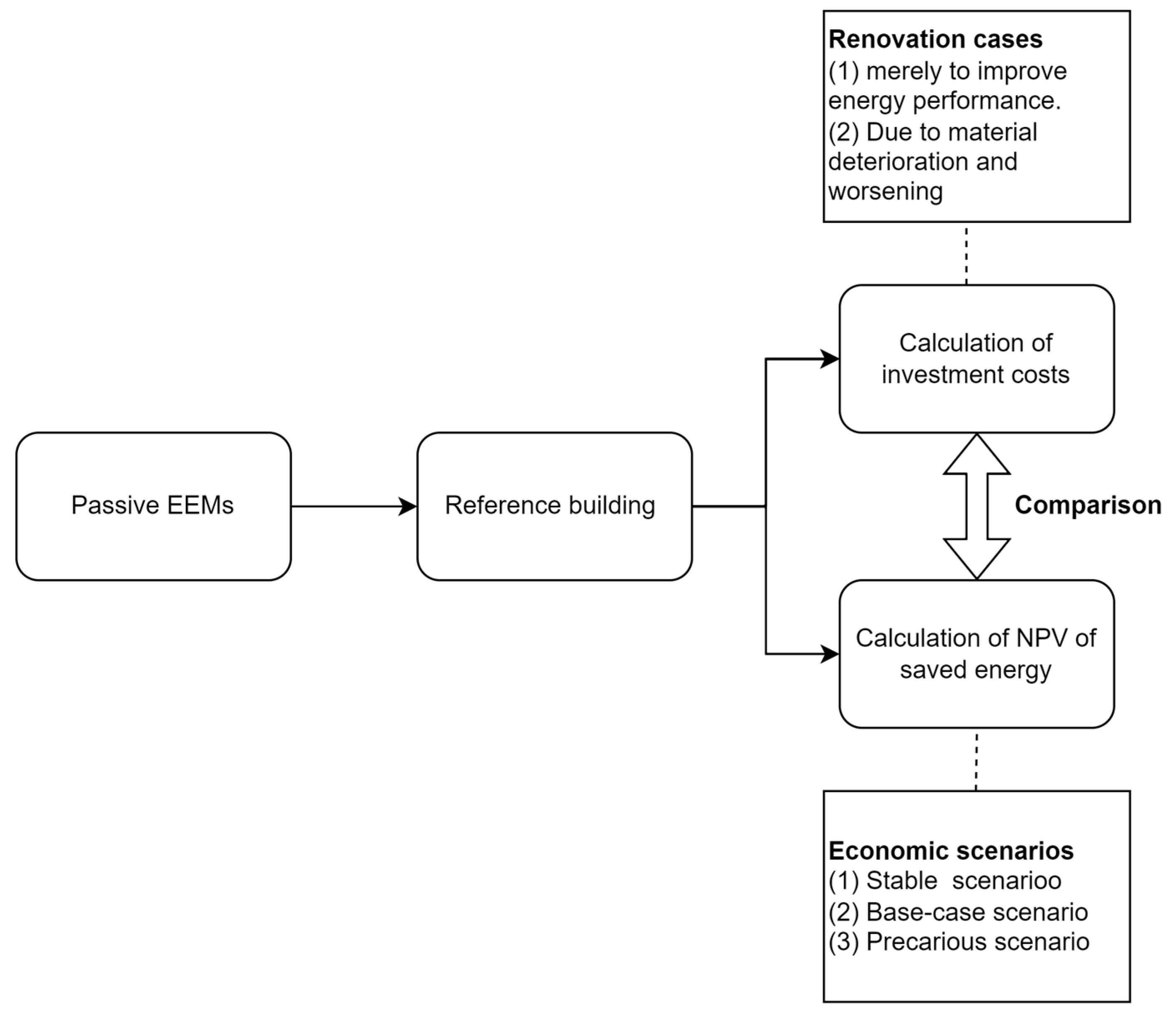

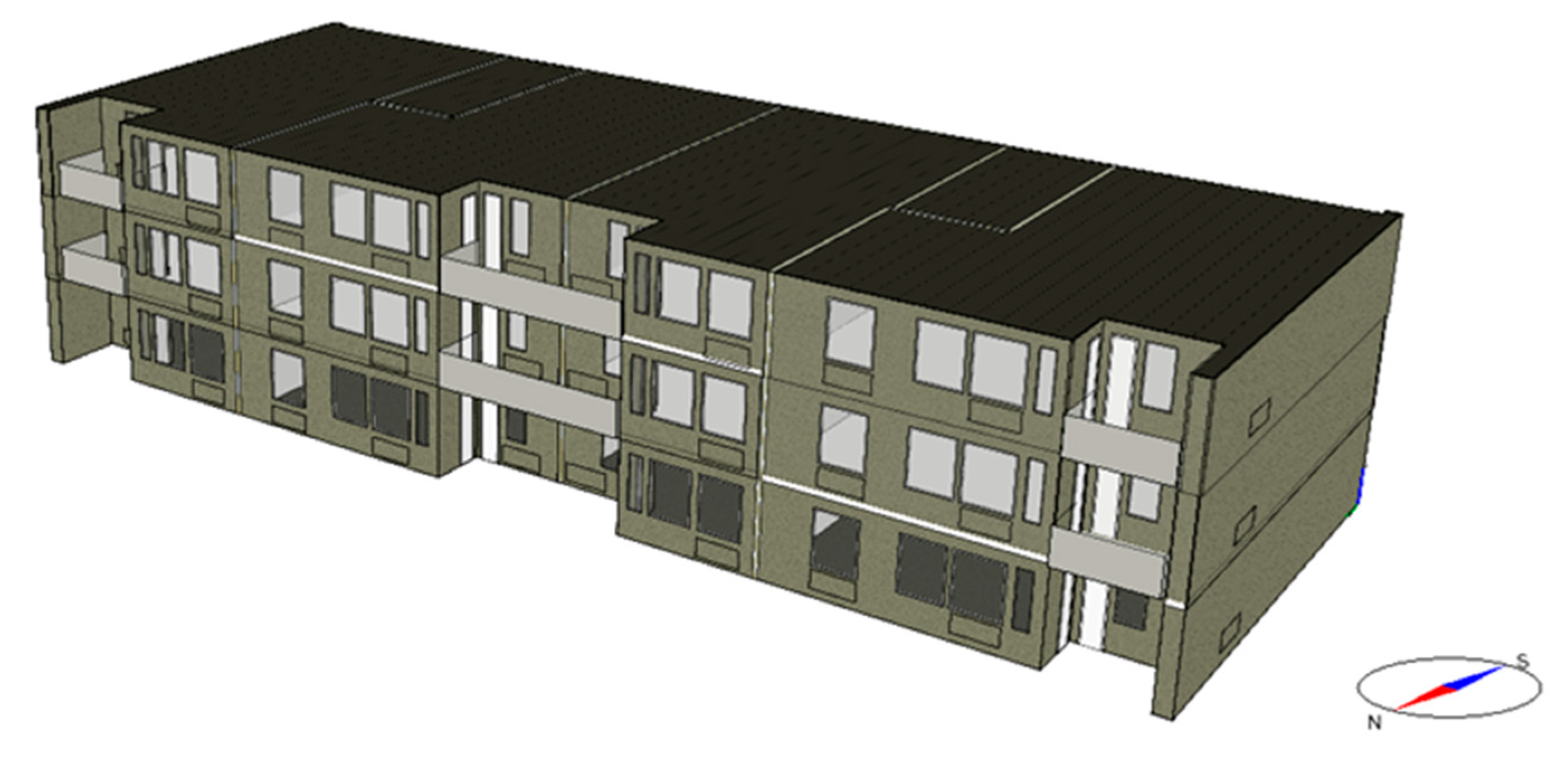
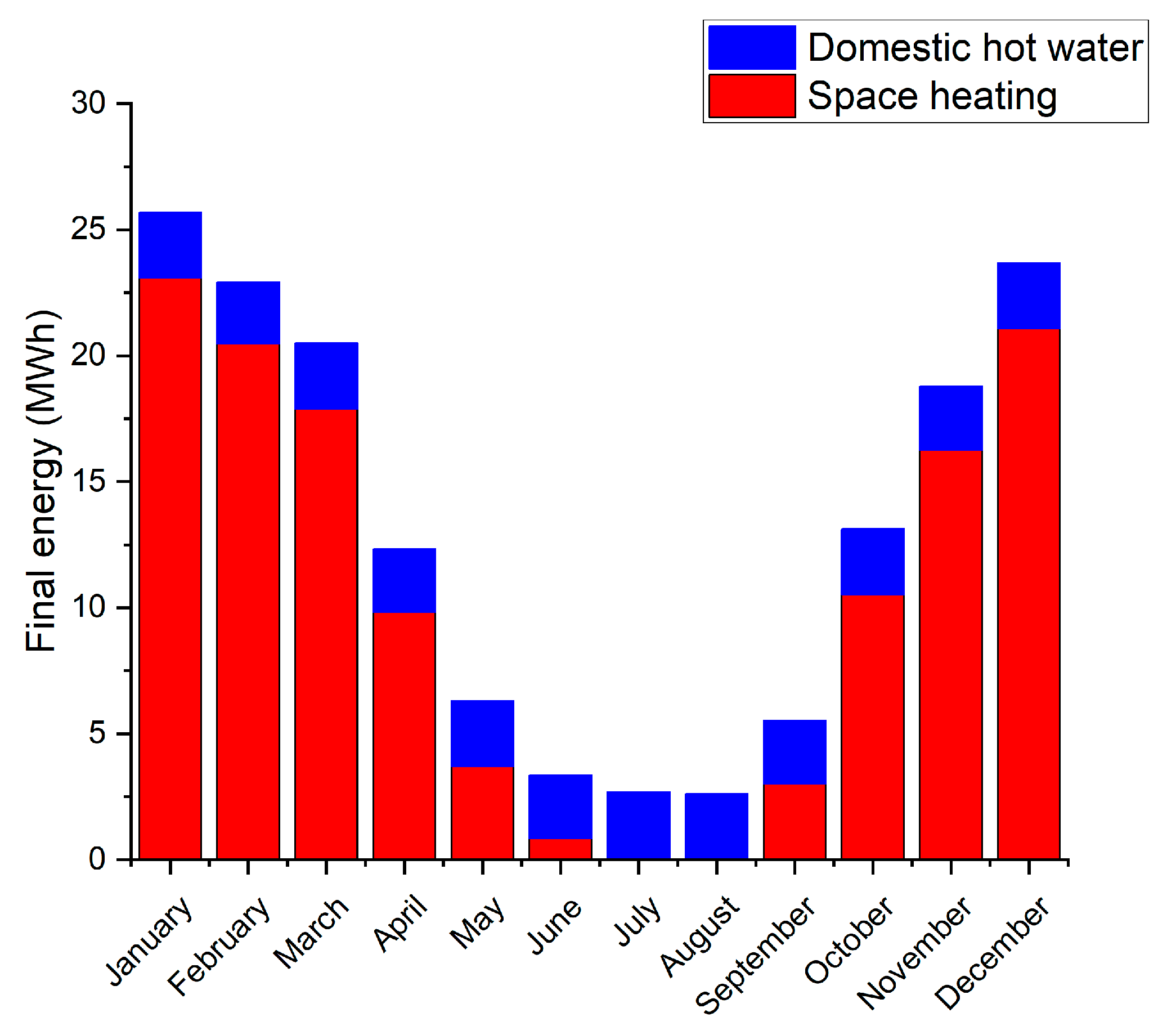

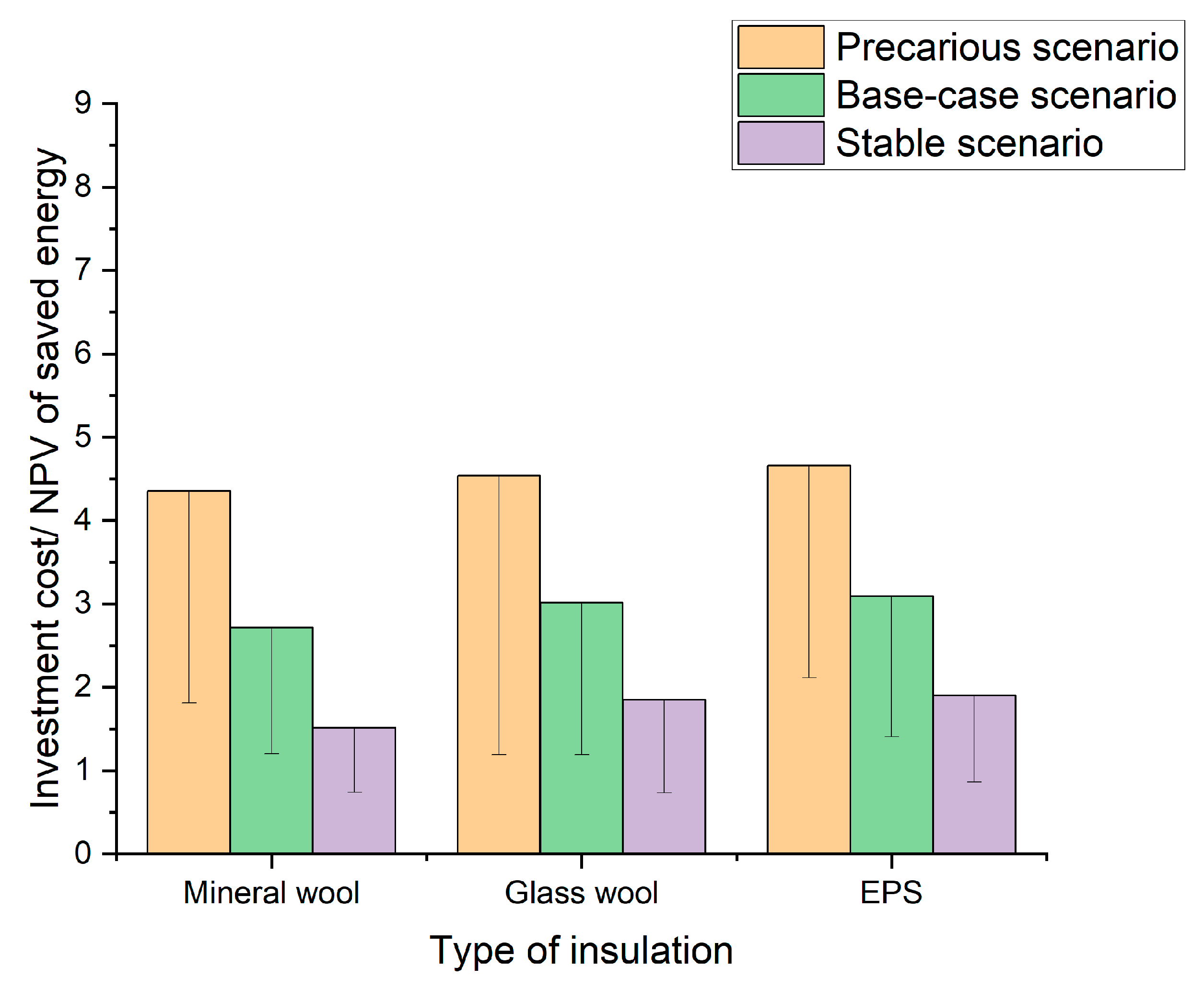
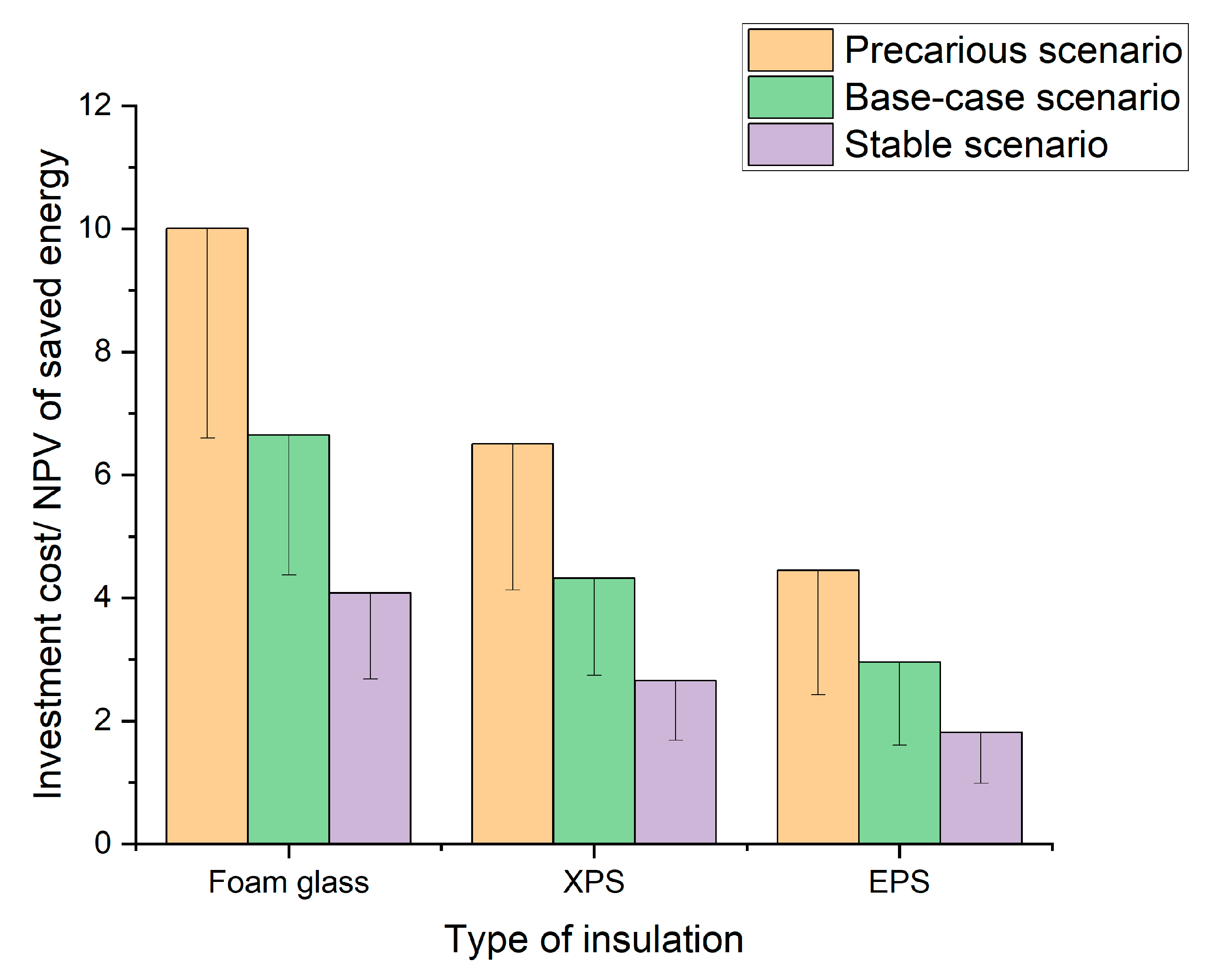

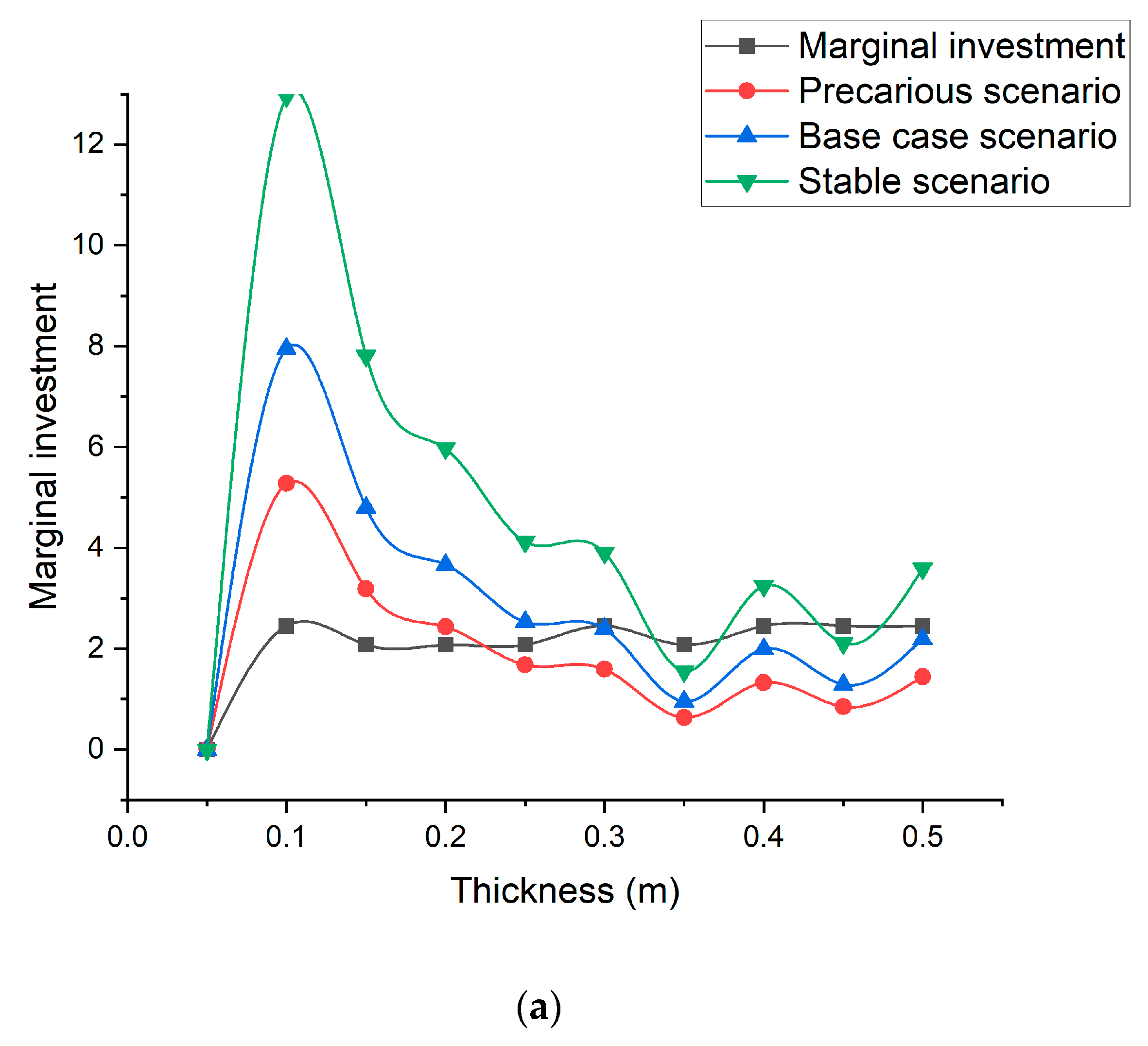
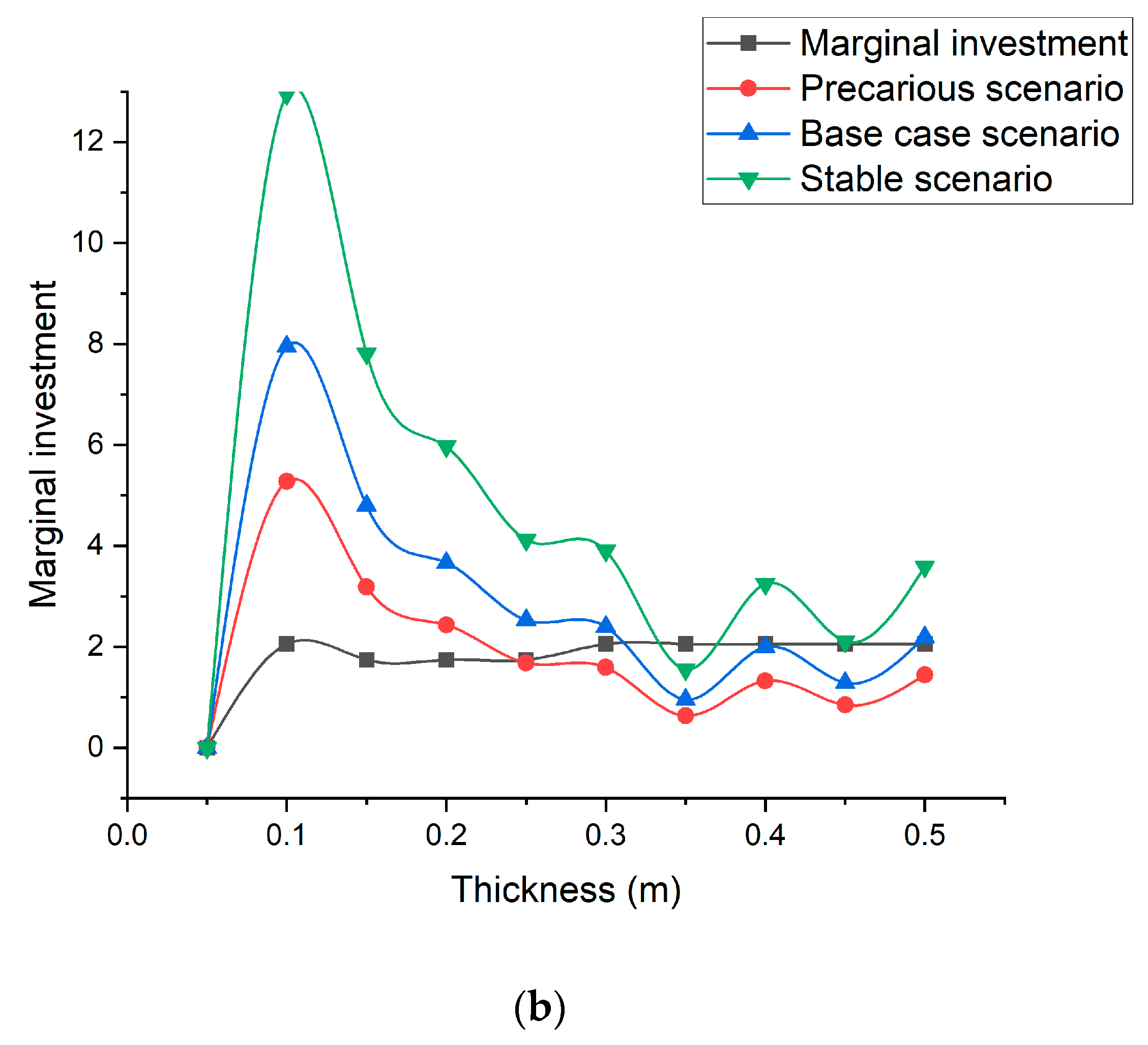
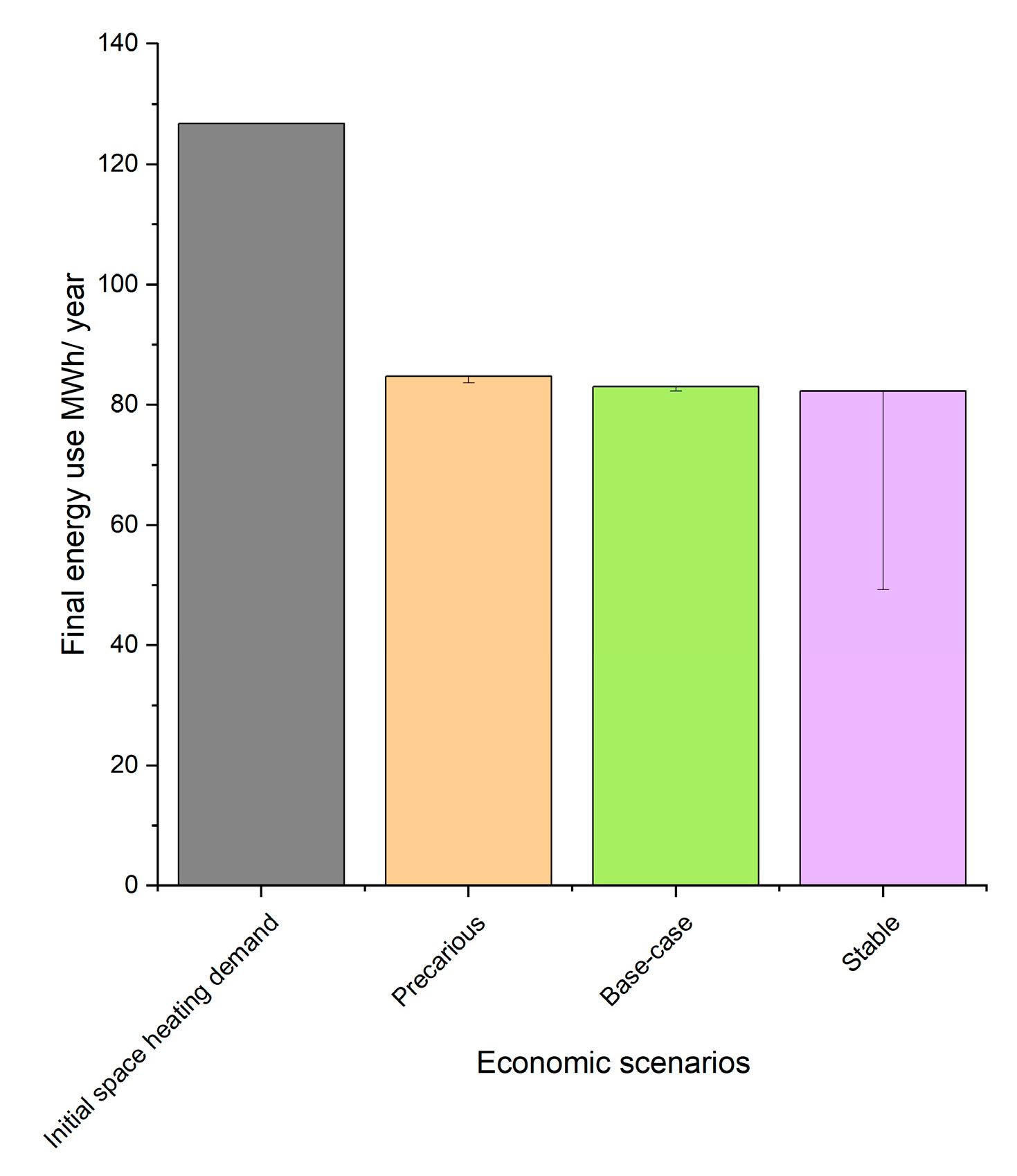
| Reference | Passive EEMs Studied | Variations Insulation Type | Renovation Cases | Key Findings and Conclusions |
|---|---|---|---|---|
| [14] | New windows of different thermal transmittance values (U-values)and different thicknesses of extra insulation for exterior and basement walls and attic floor. | No | Single |
|
| [15] | New insulation material for exterior and interior walls. Extra insulation layers for ground floors, and for ducts and hot water pipes. Existing windows replacements with high-performance alternatives. Solar shading devices. Sealing of cracks and air leakages in joists. | No | Single |
|
| [17] | Improved thermal insulations for the attic floor, basement walls and exterior walls. Efficient windows and doors. | No | Single |
|
| [18] | Additional thermal insulation thickness for external walls and roof elements. Replacement of old windows with new ones that have U-value of 1.0 or 0.8 W/m2 K | No | Single |
|
| [16] | Attic insulation improvement, basement walls and exterior walls insulation improvement. Improved windows. | No | Single |
|
| [19] | Addition of insulation to external walls, cellar walls, roof, and foundation. Replacement of existing doors with new ones that have U-values of 1.2 and 0.8 W/m2 K. | No | Single |
|
| [20] | Roof and wall insulation improvements, and window and door replacements. | Yes | Single |
|
| [21] | Expanded polystyrene (EPS) insulation and extruded polystyrene (XPS) insulation for ground floor and exterior walls. Installation of new efficient windows and doors. | Yes | Single |
|
| [22] | EPS external thermal insulation composite system (ETICS) on the existing façades. Insulation of distribution pipes. Replacement of the existing windows with low-e double and triple glazed ones. | Yes | Double |
|
| [23] | Renewing the passive (external envelopes) parts of the building, i.e., replacing the heated walls, roof, and windows with new ones. | No | Single |
|
| [24] | Incorporating insulation to roof element. Replacing exiting windows and installation of overhangs. | No | Single |
|
| Insulation Material | Thermal Conductivity [W/m K] | Density [kg/m3] | Specific Heat Capacity [J/kg K] |
|---|---|---|---|
| Glass wool | 0.033 | 16 | 640 |
| EPS | 0.037 | 20 | 1000 |
| XPS | 0.034 | 32 | 1000 |
| Mineral wool | 0.036 | 90 | 840 |
| Foam glass | 0.050 | 165 | 1000 |
| U-Value [W/m2 K] | Solar Heat Gain Coefficient (G-Value) | Solar Transmittance (T) | Visible Transmittance (Tvis) | Glass Panes | Frame |
|---|---|---|---|---|---|
| 1.8 | 0.68 | 0.60 | 0.74 | Double | Wooden frame |
| 1.2 | 0.46 | 0.42 | 0.70 | Triple | Aluminum-coated wood |
| 1.1 | 0.45 | 0.38 | 0.70 | Triple | Aluminum-coated wood |
| 0.8 | 0.40 | 0.38 | 0.70 | Triple | Aluminum-coated wood |
| Economic Parameter | Scenario | ||
|---|---|---|---|
| Precarious | Base Case | Stable | |
| Discount rate [%] | 4 | 3 | 2 |
| Annual energy price increase [%] | 1 | 2 | 3 |
| Parameter | Value | Note |
|---|---|---|
| Capacity cost [Euro/kW year] | 119.02 | For the range 50–74 kW. The capacity is determined based on the daily average demand during November–March for the outdoor temperature of −10 °C. |
| Energy cost [Euro/kWh] | The price applies to each kWh of district heating used. The prices vary between the seasons. | |
| ● 1 November–31 March | 0.044 | |
| ● 1 April–31 October | 0.026 | |
| Pumping cost [Euro/m3] | Based on the volume of district heating water being circulated. The flow fee is charged only during the winter period. | |
| ● 1 November–31 March | 0.504 | |
| ● 1 April–31 October | 0 |
| Building Envelope Element | U-Value [W/m2 K] | Total Area [m2] | Description |
|---|---|---|---|
| Doors | 3.00 | 54.7 | Wooden exterior doors |
| Windows | 2.90 | 135.5 | Double pane windows with wooden frames |
| Roof | 0.51 | 407.7 | Flat concrete roof with existing insulation of 50 mm mineral wool (λ = 0.04 W/m K) |
| Ground floor | 2.70 | 407.7 | Non-insulated concrete slab |
| Exterior walls | 0.32 | 653.4 | Pre-fabricated concrete walls with existing insulation of 100 mm mineral wool (λ = 0.04 W/m K) |
| Parameter | Value | Notes |
|---|---|---|
| Indoor temperature set points: | According to the Swedish building code [42] | |
| - Living areas | 21 °C | |
| - Common areas | 18 °C | |
| Controlled air flow of central ventilation unit | 0.35 l/s m2 | According to the Swedish building code [42] |
| Internal heat gain values | Constant profile throughout the year, based on the SVEBY program [43] | |
| - Tenants | 1.0 W/m2 | |
| - Equipment and lighting | 3.0 W/m2 |
| Economic Scenario | Renovation Case | |
|---|---|---|
| Merely to Improve the Energy Performance | Due to Material Deterioration and Worsening | |
| Precarious | Roof: 200 mm glass wool Windows: 1.2 W/m2 K | Roof: 300 mm glass wool Windows: 1.2 W/m2 K |
| Base case | Roof: 300 mm glass wool Windows: 1.2 W/m2 K | Roof: 500 mm glass wool Windows: 1.2 W/m2 K |
| Stable | Roof: 500 mm glass wool Windows: 1.2 W/m2 K | Roof: 500 mm glass wool Walls: 250 mm mineral wool Ground floor: 250 EPS Windows:1.1 W/m2 K Doors: 1.2 W/m2 K |
| Building Envelope Element | Insulation Type or Door U-Value [W/m2 K] | Lifespan at Which Cost Effectiveness Is Realized [Year] | Cost-Effective Thickness [mm] |
|---|---|---|---|
| Renovating merely to improve the energy performance of the building | |||
| Exterior walls | Mineral wool | 80 | (150–300) |
| Glass wool | 80 | (100–250) | |
| EPS | 80 | (100–250) | |
| Doors | 1.2 | 60 | - |
| 1.1 | 70 | - | |
| Renovating due to material deterioration and worsening | |||
| Doors | 1.1 | 60 | - |
Disclaimer/Publisher’s Note: The statements, opinions and data contained in all publications are solely those of the individual author(s) and contributor(s) and not of MDPI and/or the editor(s). MDPI and/or the editor(s) disclaim responsibility for any injury to people or property resulting from any ideas, methods, instructions or products referred to in the content. |
© 2023 by the authors. Licensee MDPI, Basel, Switzerland. This article is an open access article distributed under the terms and conditions of the Creative Commons Attribution (CC BY) license (https://creativecommons.org/licenses/by/4.0/).
Share and Cite
Boussaa, Y.; Dodoo, A.; Nguyen, T.; Rupar-Gadd, K. Integrating Passive Energy Efficient Measures to the Building Envelope of a Multi-Apartment Building in Sweden: Analysis of Final Energy Savings and Cost Effectiveness. Buildings 2023, 13, 2654. https://doi.org/10.3390/buildings13102654
Boussaa Y, Dodoo A, Nguyen T, Rupar-Gadd K. Integrating Passive Energy Efficient Measures to the Building Envelope of a Multi-Apartment Building in Sweden: Analysis of Final Energy Savings and Cost Effectiveness. Buildings. 2023; 13(10):2654. https://doi.org/10.3390/buildings13102654
Chicago/Turabian StyleBoussaa, Youcef, Ambrose Dodoo, Truong Nguyen, and Katarina Rupar-Gadd. 2023. "Integrating Passive Energy Efficient Measures to the Building Envelope of a Multi-Apartment Building in Sweden: Analysis of Final Energy Savings and Cost Effectiveness" Buildings 13, no. 10: 2654. https://doi.org/10.3390/buildings13102654
APA StyleBoussaa, Y., Dodoo, A., Nguyen, T., & Rupar-Gadd, K. (2023). Integrating Passive Energy Efficient Measures to the Building Envelope of a Multi-Apartment Building in Sweden: Analysis of Final Energy Savings and Cost Effectiveness. Buildings, 13(10), 2654. https://doi.org/10.3390/buildings13102654






